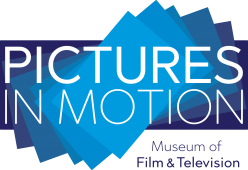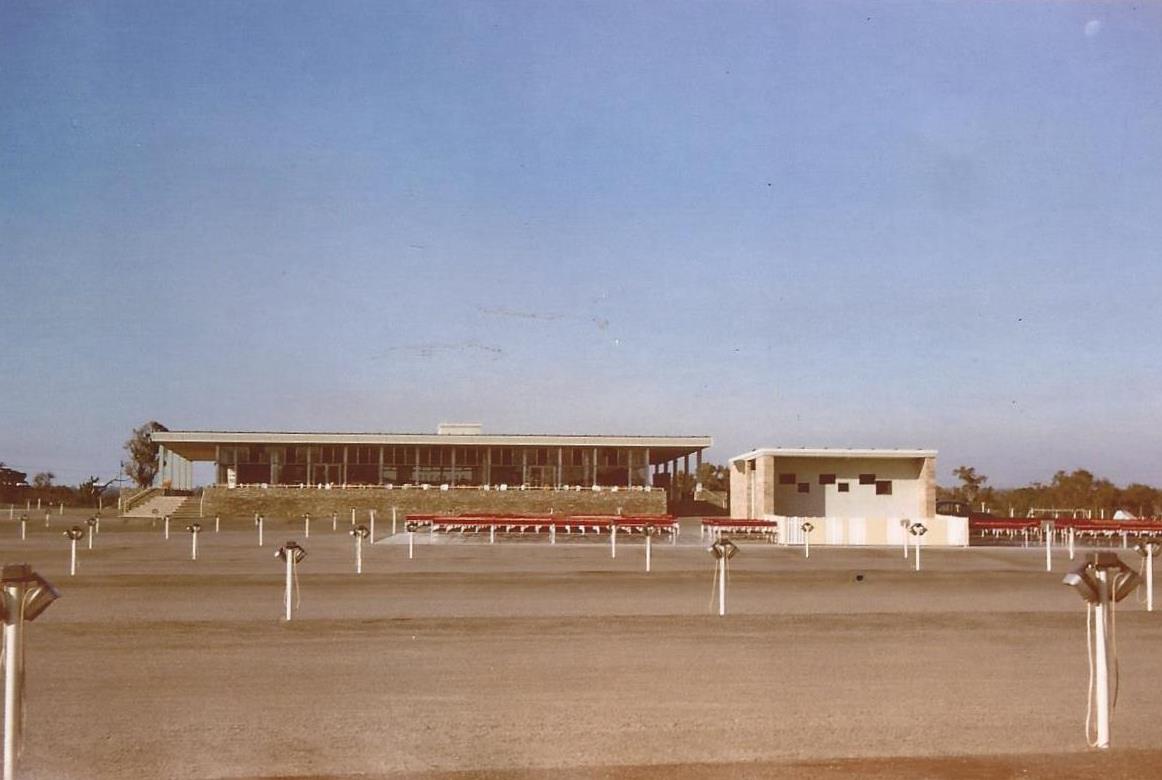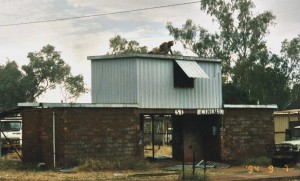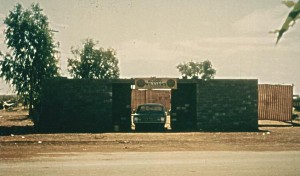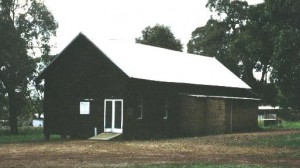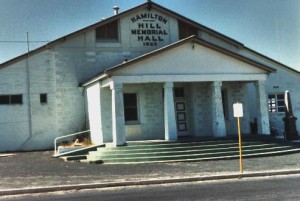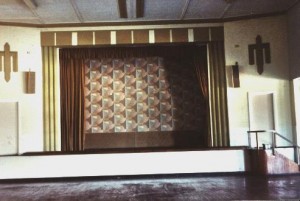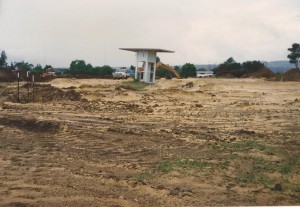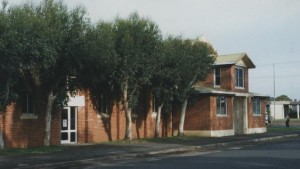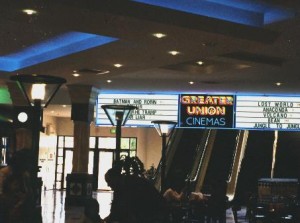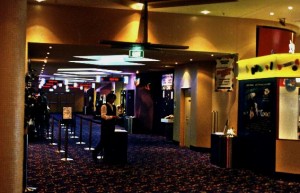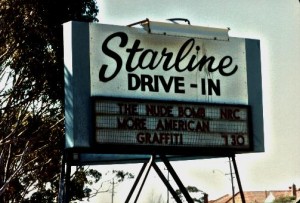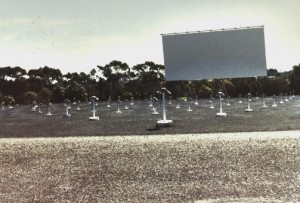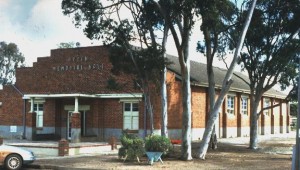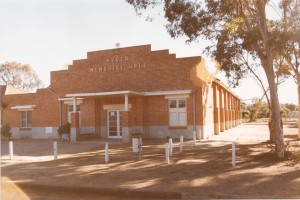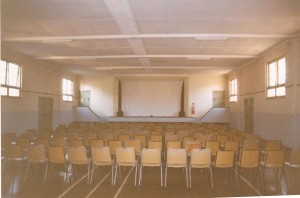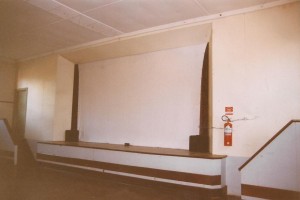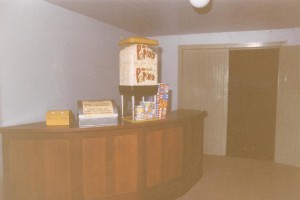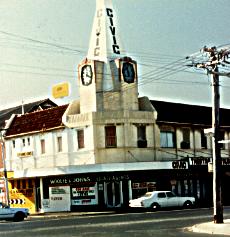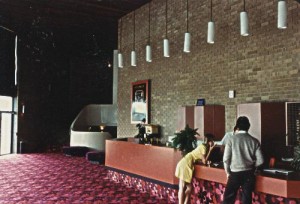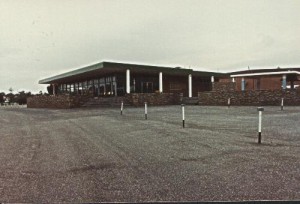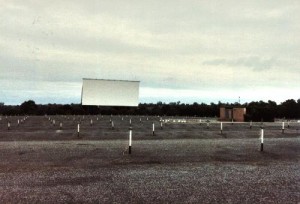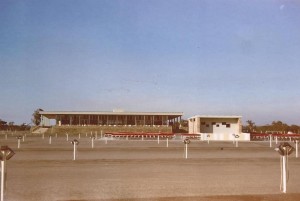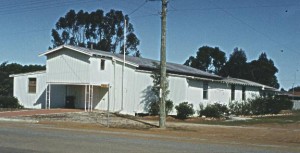Quicklinks
| Hall’s Creek | Hamel | Hamilton Hill |
| Harvey | Herne Hill | Hillarys |
| Hilton | Hyden | Inglewood |
| Innaloo | Jardee | Jarrahdale |
| Jarrahwood | Jerramungup | Joondalup |
HALL’S CREEK
OPEN AIR PICTURE CINEMA/ MAVERN STAR CINEMA, Thomas St, Hall’s Creek
Gordon Buchanan (grandson of explorer Nat Buchanan) ran a weekly screening in the late forties and early fifties, probably in the old town because he left the district in 1951. There was no town hall, so screenings took place at the back of the Roads Board office, outdoors, with the audience sitting on the ground or in their vehicles. Around 1950, the town started to be moved to the present site, but the new townsite had no picture show for several years, till school-teacher Graham Russell began screenings for the P&C in the school grounds about 1955. If the weather was bad, these screenings took place under the verandah of the adjoining AIM hostel (run for children attending the school from outback stations).
In the mid-sixties, Mavis and Ernie Bridge negotiated with the P&C to take over these screenings, and constructed a new picture gardens on a block of land they owned in Thomas street, opposite the school. This simple Picture Gardens was built for them in 1967 by Don King. It was fenced with wire mesh, with a timber bio-box built above the entrance, and brick toilet blocks on either side of this. The stage was a wooden platform on a metal frame, under the screen: this was used for concerts or other performances, because the town did not have a large enough hall. Country and western performers were particularly popular, and one photo (taken before the venue was quite complete) shows an ad for Buddy Williams above the entrance. Seating was wooden planks on steel frames.
It was called the Mavern Star Cinema, and screened twice a week. The town diary in 1969 lists Mavern Pictures on Fridays and Mondays, and School Pictures on Wednesday and Saturday, which suggest four nights of pictures for the town for at least part of its history. All these were commercial films, not educational films, for instance on Wednesday 1 October 1969 the School Pictures programme included Francis Joins the Navy and Pardners.
When Ernie Bridge entered parliament in 1980, the Bridge family moved to Perth, and the venue became very run-down: so much so that, when a screening did happen, people brought their own planks to sit on. Derek Keene and Malcolm Edwards leased it in late 1981, and spent $5000 on improvements. They bought steel frames from Kununurra Picture Gardens and had canvas made up in Perth, enough to seat about 150 people. They extended the cover from the brick toilet blocks so that there was some shelter if it rained. They painted everything, put in new toilets, and painted the screen. They ran two programmes a week, on Friday and Sunday, with films travelling from Perth and back on the Gascoyne’s trucks. They found that the audience preferred fight films above all else.
A laneway ran between the picture theatre and Thomas’ store, which Keene and Edwards also leased at that time. The laneway land was owned by the theatre, so they installed gates at either end: this allowed them to close off the laneway during screenings, and open the servery they had installed in the side wall of the store, so they could sell out onto the lane. This worked very well as a concession: they sold hot food and drinks and icecreams: on one memorable Friday night they sold 105 milk thick-shakes! Screenings could be washed out by a thunderstorm, but otherwise they ran in all seasons: people brought rugs and cushions in cold weather, and just put up with the discomfort in the heat. The venue had two Bell and Howell projectors – but no slide projector, so there was no advertising. There was nothing growing inside the fence, except one tree planted in the early days, which grew mightily after the sewerage was installed in the men’s toilets.
Keene and Edwards ran the venue till early 1983: there were 350 people at their first screening, but attendance dropped off steadily till there were only about 20 at the last one. By then, video had arrived in the town. However, the venue was not demolished till 8 September 1994. Unfortunately the available photos show the cinema incomplete (before the biobox was built) or just before demolition (in very poor repair).
Sources:Public Health Department, building permit, Battye 1459
MGM contract with G.A.Buchanan, 10 May 1949
Max Bell, Kino, no.50, December 1994, p.35
Ina Bertrand, ‘Going to the pictures in the Kimberley’, part 3, Kino 74, Summer 2000, pp.39-41
Interview (Ina Bertrand): Derek Keene (1999)
Interview (Stella Files): Ernie Bridge (1999)
Photos: 1 exterior, colour, 1967, Derek Keene
3 exteriors, colour, 1994, Derek Keene
HAMEL
HAMEL HALL, Cornucopia St, Hamel
In Hamel, a small settlement just south of Waroona, the hall was first used as a dormitory for a penal outstation, which was closed in 1907. The building was then passed over to local trustees for use as an agricultural hall, and in 1920 relocated to its present site. It is a small timber structure, unlined and with a corrugated iron roof. It has no bio-box, but was used for films before the Memorial Hall was built in Waroona.
Sources:Laurie Snell, Drakesbrook Days and Waroona Years, Shire of Waroona 1986, pp.162-4
Photo: 1 exterior, colour, 1997, Graeme Bertrand
1 exterior, b&w, 1977, Laurie Snell, Drakesbrook Days and Waroona Years, Shire of Waroona 1986, pp.162-4
HAMILTON HILL
HAMILTON HILL HALL AND GARDENS, Rockingham Rd, Hamilton Hill
Hamilton Hill Memorial Hall was built on the corner of Carrington St in 1925, and films were regularly screened there from 1943, when W. S. Palmer was registered as the exhibitor, screening three nights each week. It was a small hall, holding at first 365 seats, but seating was reduced to 260 in 1958, and to 150 in 1960. The Palmer family were connected with the business till at least 1958, then it was taken over by N. J. Woods, and in 1960 was advertised as Hamilton Hill Gardens, but it seems to have closed that year.
Sources: Film Weekly Directory, 1943/4 – 1960/61
Photos: 1 exterior (hall), colour, 1981 (Bill Turner)
1 interior (hall), colour, 1981 (Bill Turner)
HARVEY
HARVEY DRIVE-IN, Young St, Harvey
South West Cinemas (operated by A.H.Jeffries of Bridgetown) built the Harvey Drive-in on the east side of Young St, opposite the junction with Minella Rd. It had a permit for 200 cars, and opened on 12 March 1963. This led to the closing of screenings in the local hall. The drive-in closed 17 August 1984, and the land is now Percy Dewe Park and a housing estate.
Sources: Film Weekly Directory 1965/6 – 1971
Public Health Department, building permit, Battye 1459
Max Bell, Perth, a cinema history, The Book Guild Ltd, Lewes, Sussex 1986, p.135>
Interview (Ina Bertrand): Alan Larkin (1985)
Photo: 1 exterior, colour, 1980’s , Max Bell
TOWN HALL, Young St, Harvey
On their 1909 tour the Corricks visited Harvey, but it is not clear where they performed.
The hall was built on the north-east corner of the intersection of Uduc Rd and Young St, facing onto Young St. It was initially built in 1914, extended 1935. The building is constructed of red brick, with a corrugated iron roof, and a bio-box above the entrance foyer. There is a lesser hall beside the main hall along Young St, and the original Shire Offices were built beside the hall in Uduc Rd.
It is not clear when regular screenings commenced in the hall, but probably from the twenties. In 1939 Goldfields Pictures (founded in 1933 in Kalgoorlie) bought out the local operators and established a circuit, which included Harvey, Donneybrook, Bridgetown, Greenbushes and Boyup Brook, using a program sent out from Bunbury by manager Ron Elsegood and switched among the five venues. The Harvey hall was operated by Mrs Elsegood, who ferried the films and the operator to and from Bunbury. Goldfields Pictures sold out their interest in the circuit in 1946-7, with Alan Larkin buying Bridgetown and Harvey. He converted the Harvey hall to cinemascope and screened two or three nights per week, commuting from Perth each week. After Larkin left, the hall was taken over by A.H.Jeffries’ South West Cinemas, who operated it until they built the drive-in.
On 12 September 1997, the first movies for thirty years were presented in the hall: Suburban Pictures included the Harvey Hall on their circuit, screening Mr Bean.
Sources: Film Weekly Directory 1940/41 – 1967/8
Interviews (Ina Bertrand): Ron Elsegood (1985), Alan Larkin (1985), Steve Marvin (1997)
Photos: 2 exteriors, colour, 1997, Graeme Bertrand
HERNE HILL
HERNE HILL PICTURES, Herne Hill
This is listed in the Film Weekly Directory as a venue run from the late forties by D.Briggs, with 150 seats, then in the early fifties by Bart Mott’s Star Entertainments and then on A.E. Randell’s circuit. Screenings seem to have ceased by the mid-fifties, but little is known about them.
Sources: Film Weekly Directory, 1948/9 – 1953/4
HILLARYS
GREATER UNION 6/WHITFORD, Whitfords Ave, Hillarys
Greater Union’s sixplex in Whitford City shopping complex on the south-west corner of Whitfords Ave and Marmion Ave, was opened in November 1996. The entrance is in Whitfords Ave, opposite Dampier St. In 2000, it had one Senstadium.
Sources: Kino, no.53, September 1995, p.31; no.54, December 1995, p.35; no.59, March 1997, p.31
West Australian 1997 – 2000
Photos: 2 interiors, colour, 1997 (Graeme Bertrand)
HILTON
HAMILTON HILL PICTURE GARDENS/HILTON PARK GARDENS, cnr Carrington & South Sts, Hilton
The Army Camp at Melville was used during the post-war housing shortage as temporary accommodation for the State Housing Commission. In the Camp Hall, which held 200, Ken Booth, Jim Woods and a Mr Long began screening for the residents of the camp and surrounding district. Later Booth and Woods shifted this enterprise to Hilton Park and built a Picture Gardens with accommodation for approximately 1000 near the corner of Carrington Street and South Street. In 1955 Booth moved to the Centre Gardens at Willagee, and Woods carried on at Hilton Park till the gardens closed in 1964, under the combined competition from television and the nearby Starline Drive-in.
Sources: Film Weekly Directory, 1952/3 – 1961/2
West Australian 1961
Interviews (Ina Bertrand): Ken Booth (1978), N.J. Woods (1985)
STARLINE DRIVE-IN THEATRE, Carrington St, Hilton
City Theatres and Goldfields Pictures jointly bought out Hoyts’ interests in the Oriana (Fremantle) and the Skyline Drive-in Theatre, and looked for further drive-ins to add to their chain. A new company (Star Drive In Theatre Pty Ltd) was formed, in which City Theatres had a controlling interest and Goldfields Pictures had a quarter interest, to build the Starline Drive-in, in Carrington St, on the south-west corner of Jeffery St. The land was leased from the Fremantle City Council, who planned to put the proceeds towards development of the Hilton Park recreation reserve opposite the site. The drive-in was one of three for the company designed by William and Garry Leighton. By the time it opened with facilities for 350 cars, on 18 November 1960, the rash of suburban cinema closures had already begun, and the company announced that the building of the Starline was a sign of its faith in the future of the industry. Nevertheless, as insurance, they also announced that the venue would be developed into an entertainment complex for the whole family, with a swimming pool and dance floor, rather than only a cinema. Mr H. Enright moved from the Princess (Fremantle) to manage the new drive-in, which was enthusiastically greeted:
The trend at the Starline is for a smaller audience.
There will be space for 400 cars.
And there will be no need for cars to bank up on the road. There is a holding area between the road and the main gate which can accommodate about 80 cars.
When the cars enter the drive in proper they are confronted with a sign containing two arrows pointing in opposite directions.
The flow of traffic can be controlled by illuminating either of the two arrows.
Cars are directed to turn right or left, according to the volume of cars in different parts of the drive-in.
Apart from the space for about 400 cars there is an area in front of the dining and toilet block which has garden seats for 100 people.
Because the drive-in is near the sea – you can see Rottnest and Garden Island from your car – the accent in the food department will be on fish and seafood.
The company hopes to build up a reputation for this type of food. With its compact modern kitchen the drive-in can serve 1000 meals a night. (Sunday Times, 20 Nov. 1960)
The ambitious plans to develop the site were not realised, but accommodation was increased to 390 cars in 1965, and the cinema still operated in 1986. In 1988 the site was sold by Hoyts for £1mill, and by 1997 a housing estate occupied the site.
Sources: Film Weekly Directory 1960/61 – 1971
Public Works Department, Building approval 21 Dec. 1961 (Battye Library 1459)
Max Bell, Perth: a cinema history, The Book Guild, Lewes, 1986 p.128
Vyonne Geneve, ´William Leighton, architect’, Kino, no.25, Sept.1988, p.14
Daily News, 18 Nov. 1959
Kino, no.25, Sept.1988, p.23
Sunday Times, 20 Nov. 1960
West Australian 1960 – 1988
Interview (Ina Bertrand): Arthur Stiles (1985)
Photos: 2 exterior, colour, 1981 (Bill Turner)
HYDEN
HYDEN DRIVE-IN, Hyden
This was the last of the conventional drive-ins (with car ramps and speaker stands) to open. In 1975, the Beverley drive-in was dismantled, transported to Hyden on semi-trailers and re-erected at the eastern entrance to the town. Kondinin Shire were not particularly helpful in this, even to the extent of not connecting the electricity till 4 p.m. on the opening night (which may have been in 1975, though the first advertisements to appear are on 1 July 1976). The venture was initiated by a local syndicate, and the venue was managed by Graham Ford (who also operated at Merredin, Bruce Rock, and Narrembeen). It operated successfully two nights a week (Friday and Sunday) at first, but started to lose money when Hyden first received television, and behaviour at the drive-in deteriorated. It was closed in March 1985, demolished and a motel was built on part of the site (though the concession building is still recognisable nearby).
Sources: Public Health Department, building permits, Battye 1459
Shire of Kondinin, Municipal Inventory of Heritage Place, no.154
Merredin Mercury 1 July 1976, 14 October 1976
West Australian 30 July 1997, p.7
Informants: Pat & Bob Clayton (Hyden, 22 August 1997), T.J.R.Mouritz (1987)
HYDEN MEMORIAL HALL, Marshall St, Hyden
The Hyden Memorial Hall is built on the north-west corner of the junction of Marshall and Lynch Sts. The Municipal Inventory describes it thus:
The red face brick structure has a corrugated iron gable roof which has been clad over with decramastic tiles. The front facade is symmetrical about the hall proper and extends on the south to link with the front wall of the CWA building. The stepped parapet steps down to the CWA. The hall proper has a central double entry which is flanked by a set of two windows each side. A flat concrete roof covers the entry and forms an “eyebrow” over the windows. The roof is supported by brick piers with small columns. The facade has been rendered to window sill height. Wandoo floor, Hyden bricks for the interior walls. Inferior Japanese roof iron which was painted sheet by sheet on both sides prior to laying on the roof.
The townsite was established in 1933, but the hall was not built till much later: the foundation stone was laid in November 1952. Time had been spent in raising funds within the community, and in making the bricks locally because of post-war shortages of building materials. There was also delay while the local committee was established as the legal entity to build the hall. However, it was officially opened with a debutante ball on 12 May 1953.
It had a built-in bio-box, as film screenings were one of the intended purposes for the hall. Bart Mott’s circuit had occasionally operated as far south as Hyden in the early days, but it was Paddy Baker who moved his regular weekly screenings from the sports pavilion to the new hall as soon as it opened.
There were frequent breakdowns, marked by slow hand-clapping from the audience. Babies were left in cars outside the hall, the mothers taking turns to check: there were no fears for their safety, and this co-operative system made it possible for everyone to enjoy the screenings.
Basil Colmer took over screenings in 1963 and continued to about 1968, ceasing well before the drive-in opened.
Sources: Film Weekly Directory 1940/41, 1954/5 – 1967/8, 1971
Shire of Kondinin, Municipal Inventory of Heritage Places, no.12
Informants: Pat & Bob Clayton (1997)
Photos: 1 exterior, b&w, n.d., Shire of Kondinin, Municipal Inventory of Heritage Places, no.12>
1 exterior, colour, 1997, Graeme Bertrand
1 exterior, colour, 1996, Roy Mudge
3 interior, colour, 1996, Roy Mudge
INGLEWOOD
CIVIC THEATRE AND PICCADILLY PICTURE GARDENS, 919 Beaufort St, Inglewood
The Piccadilly Picture Gardens was built in 1926. It had a lattice fence covered with creepers, and was attractively laid out. Seats and draperies were destroyed in a fire on 5 January 1928, but the theatre itself was not damaged and it soon re-opened. In approximately 1937, the Civic Theatre was built next door on the corner of the site, and the venue was referred to either as the Civic and Gardens or as the Civic Theatre and Piccadilly Gardens. The theatre and gardens each held 1000. In 1941, the operator was Percy Tyler. This was one of the suburban venues taken over in the forties by Goldfields Pictures. Film screenings here ceased in 1962, and in 1969 the building was converted for use as a nightclub.
Sources: Public Health Department, building permit, Battye 1459
Max Bell, Perth – a cinema history, The Book Guild, Lewes, Sussex, 1986, pp.24-5, 62
Vyonne Geneve, Significant buildings of the 1930s in Western Australia, June 1994, National Trust of Australia (WA)/ National Estate Grants Programme, vol.1
Everyone’s, 11 January 1928, p.36
West Australian, 1933 – 1962
Interviews (Ina Bertrand): Ron Elsegood (1985), Lou Starr (1985), John Marsden (1997)
Interview (Ina Bertrand & Bill Turner): Graham Norton (1981)
Photo: 1 exterior, colour, 1981 (Bill Turner)
1 exterior, b&w, 1986 (Max Bell, Perth – a cinema history, p.25)
INNALOO
INNALOO GARDENS, Barnes Rd, Innaloo
This gardens was situated in Barnes Rd, next to the Morriss Hotel. It opened in 1957 and closed in 1963.
Sources: West Australian, 1960 – 1963
METRO DRIVE-IN/ INNALOO CINEMA/ GREATER UNION 8/ GREATER UNION MEGAPLEX INNALOO, 8 Liege St, Innaloo
On 20 April 1957, M.G.M. opened the Metro Drive-in with a gala screening of High Society, attended by more than 300 notables: according to the West Australian (18 April 1957) this included ‘members of Parliament, civic leaders and heads of the commerce, industry and theatrical sections of the community’. The venue was claimed to be at that time the largest in the country, with provision for 950 cars, and a holding area at the rear for a further 600 waiting for the next session. It had a four-lane entrance to the 22 acre site, and seating accommodation for 400 walk-ins. The screen was advertised as one of the two largest in Australia, at 72 feet high, and bolted into 500 tons of concrete foundation, to withstand winds of up to 80 miles per hour. A nurse was employed to supervise the children’s playground, which was securely fenced. There were even attendants to treat windscreens with a water-repellant solution so the screen would remain clearly visible despite rain. Restaurant patrons could eat while they viewed through the glass windows and heard the sound broadcast over speakers. Parents could heat up baby food or bottles, and infants’ changing facilities included provision for washing and drying nappies
Capacity was increased in 1968 to over 1000 cars. In the early days, nearby residents found living with a drive-in rather uncomfortable, and there were many complaints of noise and traffic congestion, but these eventually settled down.
After the drive-in was taken over by Ace Theatres in 1971, the Innaloo Cinema seating 400 was built further along the street at no.57 Liege St, and opened 13 December 1973, the first new hard-top in the metropolitan area for twenty years. It was of octagonal design, with the whole of the front facet in glass. The auditorium was also octagonal in shape. Interiors favoured simplicity, with exposed brick walls, but comfort was suggested also by lavish carpeting extending up some of the vertical surfaces. The cinema was sited away from the road, on a rise which made it visible from the surrounding district, and with plenty of car-parking space.
In 1984, the drive-in was twinned and all three sections of the venue continued to operate. Then on 16 December 1990 Greater Union opened an eight-plex on a corner of the site, closing the old hard-top while it was refurbished and incorporated into the multiplex, but continuing to run the smaller twin drive-in beside it. The drive-in closed in November 1993, and the site was cleared for use as a car park for the multiplex next door. In 1994 the multiplex added three more screens, bringing it to a total of eleven – the largest number in a single complex in Australia at that time. One was a Megascreen Cinema, 20 metres wide, seating 560 patrons. The old Innaloo Cinema, now incorporated into the development, became Cinema 4. Then in 1996 plans were announced to add ten screens to the eleven already in operation! The final result was a little more modest, but still the largest complex in the state at the time: in late 1998, the complex re-opened with 16 screens, including 3 Megascreens and one Senstadium. In 2003 it was reported that ‘Greater Union has spent in excess of $3 million on the now updated cinemas including the conversion of another two screens to Gold Class’ (Kino, no.85, p.43)
Sources: Film Weekly Directory 1957/8 – 1971
Public Health Department, building permits, Battye 1459
Max Bell, Perth – a cinema history, The Book Guild, Lewes, Sussex, 1986, pp.29-30, 127-8
Max Bell, ´Greater Union 8′, Kino, no.37, September 1991, p.16
Vyonne Geneve, ´William Leighton, architect’, Kino, no.25, September 1988, pp.7 – 15
Australasian Exhibitor, 5 July 1956; 29 November 1976
Daily News, 11 December 1957; 11 December 1973, p.21
Kino, no.22, December 1987, p.23; no.25, September 1988, p.23; no.29, September 1989, p.23; no.35, March 1991, p.24, no.36, June 1991, p.24; no.42, December 1992, p.32; no.47, March 1994, p.31; no.48, June 1994, p.32; no.49, September 1994, p.31; no.57, September 1996, p.31; no.63, Autumn 1998, p.35; no.85, Spring 2003, p.43.
Film Weekly, 25 April 1957, p.1
Film Weekly Directory, 1957/8 – 1971
West Australian, 18 April 1957, 13 December 1973, 1957 – 2000
Photos: 1 exterior (Greater Union 8), b&w, Kino, no.37, September 1991, p.16 (Max Bell)
1 exterior (Innaloo cinema), b&w, (Max Bell, Perth – a cinema history, p.30)
1 exterior (drive-in), b&w, n.d. (Max Bell, Perth – a cinema history, p.127)
1 exterior (drive-in), colour 1961, Kevin Hooper
1 exterior (Greater Union Megaplex), colour, 1997, Graeme Bertrand
2 exteriors (Metro Drive-in), colour, 1981 (Bill Turner)
1 exterior (Metro cinema), colour, 1981 (Bill Turner)
1 interior (Metro foyer), colour, 1981 (Bill Turner)
WALDORF GARDENS AND SCARBOROUGH PICTURES, 16 Muriel Ave, Innaloo
In 1948 regular screenings were begun in the Innaloo Hall, which held 150 people. Later that year, the gardens holding 4-500 patrons were opened and the screenings moved there, under various names, including Scarborough Pictures, and Waldorf Gardens. After the gardens closed in 1965, a liquor store was built on the site.
Sources: Film Weekly Directory, 1948/9 – 1964/5
West Australian, 1956 – 1960
Photo: 1 exterior, colour, 1981 (Bill Turner)
JARDEE
HALL, Struggle St, Jardee
Jarnadup mill was one of the major timber-processing plants in the south-west, with a small settlement for mill workers built around it. The hall was built in 1912, at the foot of Struggle St, where the log truck route swung round. It was of timber, with a corrugated iron roof and was used as a school as well as for all of the town’s social activities. Local historian Doreen Owens (p.61), describes early films in this hall:
Jones and Tate brought ´the pictures’ to Jarnadup on Friday night – hand-operated machine and carbide lights. ´We kids used to fight for the chance to go round the streets ringing a cowbell and calling “Pictures tonight” and the name of the film’, said Norm Jeffree, son of the mill foreman. The advertising boys would then get in free while others paid the 3d entry fee. Arch Tickle played the piano for the silent movies, often with great gusto.
In 1924, the name of the settlement was shortened to Jardee, and it grew slowly, as timber prospered. The mill was burned out twice (in 1948, and again in 1955), but rebuilt each time, and the second time electrified. This enabled electricity to be provided throughout the town, including the hall, and the P&C committee purchased a 16mm projector. Doreen Owens (pp.181-2) explains:
For quite some time the P&C added to its funds by showing pictures in the hall. Eventually, the local commercial cinema considered that it was suffering from the competition so the P&C shows were discontinued. The Sunday school, however, was able to show programmes of a religious nature on Sunday nights, until the advent of television.
The Film Weekly Directory lists Allan Jones as the commercial exhibitor here from 1940 to 1958.
Sources: Film Weekly Directory 1940/41 – 1957/8
Doreen Owens, Jardee: the mill that cheated time , UWA Press 1994
Photo: 1 exterior, b&w, n.d., Doreen Owens, Jardee: the mill that cheated time, UWA Press 1994, p.37
JARRAHDALE
MECHANICS INSTITUTE/ HALL, Munro St, Jarrahdale
Jarrahdale was a mill town, with a small timber hall, built in 1914.
At the turn of the century, when films first arrived in Western Australia, Jarrahdale was a rural area, but still close enough to Perth to occasionally see films. So, Heller’s Mahatma Company visited Jarrahdale on their way south as early as February 1901, and the Salvation Army Biorama Company in October 1904. The English and American Kinetoscope appeared in Jarrahdale in August 1908 and Vincent’s Empire Pictures were there in October 1908.
The first regular circuit to visit Jarrahdale seems to have been Bob Perrie, replaced later by Roch Evans’ Modern Cinemas circuit, which visited fortnightly with Ken Alexander as projectionist. This circuit was purchased by Charlie Legg in 1941, who tells the story of how one night during a film screening a fire broke out in the town, and the whole audience rushed outside to watch, the film suspended until the excitement died down and people returned to the hall.
In 1947, administration of the hall passed to the Road Board. In 1949, Legg sold the business to Lew Punch, who developed two travelling circuits – one in the wheatbelt (Dalwallinu, Williams, Wandering, Jarrahdale, Serpentine, Buntine, Kalannie, Wubin, Chidlow) and one in the north (as far as Bindoon). He, too, provided his own power plant, and travelled with his wife, who sold the tickets.
The last exhibitors in the hall seem to have been J. Tilka, who was listed in the Film Weekly Directory from 1958/9 to 1960/61, and R.M.Holland listed in 1960/61.
Sources: Film Weekly Directory 1940/41 – 1960/61
Neil J.Coy, The Serpentine: a history of the Shire of Serpentine-Jarrahdale, Shire of Serpentine-Jarrahdale, Mundijong 1984, p.113
Interview (Ina Bertrand): Charles Legg (1997)
Interview (Colleen Pead): Ken Alexander (1986)
Correspondence with Judy Love, Mundaring & Hills Historical Society, 19 June 1997, including notes of interview with Lew Punch
Limelight Picture Show Tours, http//:www.abc.net.au/limelight/docs/tours
JARRAHWOOD
HALL, Jarrahwood
One of Allan Jones’ travelling picture show vans visited Jarrahwood in the forties and fifties, though it is not clear where he screened or when these screenings ceased.
Sources: Film Weekly Directory 1940/41 – 1957/8
Interview (Ina Bertrand and Irma Whitford): Allan Jones (1978)
JERRAMUNGUP
JERRAMUNGUP TOWN HALL, Memorial Rd, Jerramungup
Settlement in the area dates back to 1848, but the township of Jerramungup was not established till 1957, less than two years after the first soldier settlers took up land nearby. So it is remarkable that a Town Hall was built as early as 1958. It is a large building, metal-framed with corrugated iron cladding, recycled from local shearing sheds. It was built with funds raised by the community, and had a biobox from the beginning – built on pillars on the front of the hall with entrance to the hall underneath it.
Films were screened there in the fifties and sixties by circuit showmen, including Basil Colmer in the late sixties.
In the eighties, Frank Terry toured sometimes through Jerramungup. For the screening of The Man from Snowy River he had 226 people in a venue that had only 173 chairs, with the rest of the audience finding somewhere to sit on the floor. But in the nineties there were no screenings in the town.
Sources: Film Weekly Directory 1965/6 – 1967/8
Shire of Jerramungup, Municipal Inventory
Informant: Lyn Parker (Lake Grace, 21 August 1997)
Photos: 1 exterior, b&w, n.d., Shire of Jerramungup, Municipal Inventory
1 exterior, b&w, 1997, Graeme Bertrand
JOONDALUP
LAKESIDE CINEMAS, cnr Boas & McLarty Aves, Joondalup
The state government owns the land on which the suburb of Joondalup is built, and enters into joint ventures with commercial enterprises to supply goods and services to this new area. Greater Union had such an arrangement to open a multi-plex in the Lakeside shopping centre. In 1995 it was said to be eight screen and in 1996 ten screens, but on 28 November 1998 it opened with six screens, including 2 Senstadiums. These were described as having ‘stadium seating, multi format Digital Sound, and high-back couple-seats with lift up arm rests.’
Sources: Kino, no.41, September 1992, p.27; no.49, September 1994, p.31; no.54, December 1995, p.35; no.63, Autumn 1998, p.34; no.67, Autumn 1999, p.31; no.77, Spring 2001, p.27.
West Australian 1999 – 2000
